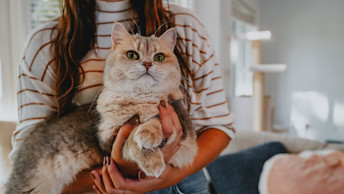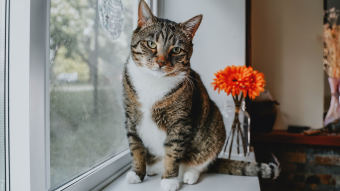February 22, 2024
Struvite Crystals in Cats: Management & Discouragement

Urinary health is a major topic when it comes to cats. The urinary system includes the bladder, kidneys, and urethra, all which function together to remove filtered waste, including certain minerals and compounds. The health of this system is critical for overall wellbeing and is heavily influenced by proper hydration, stress, and obesity, among other factors4,5,6.
In cats, there are many concerns which can be related to a urinary system issue, which can all be captured under the umbrella term of feline lower urinary tract disorder (FLUTD). One of the most common concerns under this umbrella is the formation of stones and urinary crystals in cats3,5,7.
What Are Struvite Crystals and Stones?
There are multiple types of urinary stones, however the most commonly diagnosed are "struvite”1,8. Struvite crystals can be a normal component of healthy cat urine, however when they aggregate into stones, they can become a painful and serious concern which warrant veterinary attention8.
Struvite crystals and stones are comprised primarily of the minerals magnesium and phosphorus8. They tend to form when the urine is concentrated, and when pH is alkaline (above neutral (7))8. There are a number of things pet parents can do to help prevent stones and crystals, including minimizing stress, keeping your cat at a healthy weight, keeping litterboxes clean, and choosing a diet designed to support a healthy urine pH4,5,8.
What Causes Struvite Crystals in Cats?
Research hasn’t been able to pinpoint a single cause of struvite crystals and stones just yet, as there are many factors involved.
Factors affecting struvite crystal development
- An alkaline environment (a high pH)
- Dehydration, leading to highly concentrated urine
- Environmental stress
- Obesity
Preventing Struvite Crystals
There are a few key ways cat owners can help prevent struvite stones and crystals from forming in their cat's urine:
Urinary Cat Food
Feeding your cat a specially formulated diet specific to urinary health is a great way to help discourage crystal development. Urinary health foods targeting struvite development are designed to create a moderately acidic urine pH that discourages the formation of struvite crystals. These diets may also feature controlled magnesium and phosphorus levels—the primary minerals that make up struvite crystals.
Increased Water Intake
Encouraging your cat to drink more water can help dilute the urine and discourage any minerals being excreted from lumping together to form crystals.
Make sure fresh water is always available. Consider getting a cat water fountain since many cats prefer running water.
Adding wet food as a portion of their daily intake can also help, as moisture content is very high in these foods.

Recommended Solution
Wet Cat Food Recipes
Made with high-quality animal proteins and antioxidant-rich cranberries for to support your cat's healthy urinary tract.
View wet food recipes
Many urinary health recipes feature increased key minerals, such as sodium, which can help encourage the natural thirst response and increase water intake.
Stress Reduction
Stress is a common thread of many FLUTD and crystals cases, so reducing and mitigating stress is key. Ensure your cat has places to hide, climb, scratch, and observe their surroundings. Provide interactive toys for playtime and quality time with your cat each day. Limit major changes to their routine or environment when possible. A happy, low-stress kitty is less prone to FLUTD issues, including crystals.

Prognosis for Cats with Struvite Crystals
If stones do form, a therapeutic diet designed to dissolve the stones and restore urinary health must be used2.
These special dissolution diets are available only through a veterinarian and are considered medicinal.
Once a dissolution protocol has been completed, and no struvite stones remain, it is ideal to feed a diet which can help maintain urinary health. Struvite crystals can recur if the underlying causes are not addressed. Things like diet, hydration, and stress need to be managed to prevent the crystals from returning.
The prognosis for cats with struvite crystals is often good when proper treatment is provided. With appropriate veterinary care and follow-up, many cats with struvite crystals fully recover and lead normal, healthy lives.
When to See a Vet
If your cat is exhibiting any of the following symptoms, it's important to schedule a vet appointment right away:
Straining to urinate
Cats with struvite crystals often have difficulty passing urine and will strain while trying to go. This is because the crystals irritate the bladder wall and urethra, making urination painful. Straining while peeing is one of the most common signs that a cat may have crystals. In some cases, a stone may be completely blocking the urethra, which is cause for major alarm and is a medical emergency. This occurs most often in male cats due to their anatomy.
Peeing outside the litter box
If your cat starts urinating outside the litter box, this could be another indicator of discomfort or trouble urinating due to struvite crystals. Cats are creatures of habit, and a change in their litter box behavior is usually a sign of a problem.
Small, frequent urination
Cats with crystals will frequently make many trips to the litter box to urinate just a little bit each time. This is because the crystals make it uncomfortable for the cat to hold urine. Frequent urination is another telltale sign of crystals.
Blood in urine
Crystals can cause damage and inflammation to the urinary tract, leading to blood in the urine, also known as hematuria. Any presence of blood is abnormal and requires an immediate vet visit.
Crying when urinating
Struvite crystals cause pain and discomfort when urinating. A cat may cry out or meow when peeing because of this discomfort. This vocalization is a clear sign that something is wrong.
Note: Male cats are at higher risk
Urinary troubles, especially those related to struvite crystals, are more common in male cats. This is due to the narrower and longer urethra in male cats, which can more easily become obstructed.
These symptoms listed are among the most common and recognizable signs of urinary issues like struvite crystals, but it's important to remember that cats are adept at concealing pain, so regular vet visits and urinalysis play a crucial role in monitoring and maintaining their health.
If you notice any of these symptoms, don't delay - call your vet right away to schedule an appointment. Catching struvite crystals early is key to successful treatment and prevention of more serious complications down the road. Your vet can help diagnose the issue and get your cat started on the path to feeling better.
Cannon, A.B., J.L. Westropp, A.L. Ruby, and P.H. Kass. 2007. "Evaluation of Trends in Urolith Composition in Cats: 5230 Cases (1985–2004)." Journal of The American Veterinary Medical 23: 570–576.
Forrester, S.D., and P. Roudebush. 2007. "Evidence-based Management of Feline Lower Urinary Tract Disease." Veterinary Clinics of North America: Small Animal Practice 37, no. 3.
Grauer, G.F. 2013. "Current Thoughts on Pathophysiology & Treatment of Feline Idiopathic Cystitis." Today's Veterinary Practice, 38-41.
Kurum, H., and E. Yalcin. 2023. "Effects of Multimodal Environmental Modification in Crystal-Related Feline Lower Urinary Tract Diseases." Brazilian Journal of Veterinary and Animal Science 75, no. 4.
Lekcharoensuk, C., C.A. Osborne, and J.P. Lulich. 2001. "Epidemiologic Study of Risk Factors for Lower Urinary Tract Diseases in Cats." Journal of The American Veterinary Medical 218: 1429–1435.
Osborne, C.A., J.P. Lulich, and R. Thumchai, et al. 1996. "Feline Urolithiasis: Etiology and Pathophysiology." Veterinary Clinics of North America: Small Animal Practice 26: 217–232.
Watson, ADJ., H.P. Lefebvre, and J. Eliot. 2022. "Urine Specific Gravity." International Renal Interest Society. Accessed February 13, 2024. http://iris-kidney.com/education/urine_specific_gravity.
Weir, M., and C. Barnette. "Struvite Bladder Stones in Cats." VCA Animal Hospitals. Accessed February 13, 2024. http://vcahospitals.com/know-your-pet/struvite-bladder-stones-in-cats.



